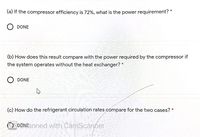
Introduction to Chemical Engineering Thermodynamics
8th Edition
ISBN: 9781259696527
Author: J.M. Smith Termodinamica en ingenieria quimica, Hendrick C Van Ness, Michael Abbott, Mark Swihart
Publisher: McGraw-Hill Education
expand_more
expand_more
format_list_bulleted
Question
kindly answer this chemical engineering thermodynamics problem SKETCH/DRAW necessary diagrams and illustrations. State all assumptions, conditions and conclusions
properly. Thank you so much

Transcribed Image Text:(a) If the compressor efficiency is 72%, what is the power requirement? *
DONE
(b) How does this result compare with the power required by the compressor if
the system operates without the heat exchanger? *
O DONE
(c) How do the refrigerant circulation rates cómpare for the two cases? *
OS DONEanned with CamScanner

Transcribed Image Text:A vapor-compression refrigeration system is conventional except that a countercurrent heat exchanger is
installed to subcool the liquid from the condenser by heat exchange with the vapor stream from the
evaporator. The minimum temperature difference for heat transfer is 5°C. Tetrafluoroethane is the
refrigerant (Table 9.1, Fig. F.2), evaporating at -8°C and condensing at 24 °C. The heat load on the
evaporator is 2000 kJ/s.
Expert Solution
This question has been solved!
Explore an expertly crafted, step-by-step solution for a thorough understanding of key concepts.
This is a popular solution
Trending nowThis is a popular solution!
Step by stepSolved in 4 steps

Knowledge Booster
Similar questions
- Materials Science and Chemical Engineeringarrow_forwardcan someone show how to obtain opeerating line from component balance and boil up ratioarrow_forwardIn the equilibrium-stage model equations, are K-values and enthalpies counted as variables? Are the equations used to compute these properties counted as equations?arrow_forward
- A steel with BS code 230M07 representsarrow_forwardFor each of the endothermic and exothermic reactions, explain which reactor type is optimal for adiabatic operation.arrow_forwardSelect all statements that apply to constant volume calorimetry. A coffee cup calorimeter is used. A bomb calorimeter is used. The system is the reaction or process. The system is the water plus the calorimeter. The surroundings include the reaction or process only. The surroundings include the water plus the calorimeter. The temperature of the water will always increase. The temperature of the water will always decrease. The temperature of the water could increase or decrease. It is used to measure heat of combustion. It is used to measure heat of solution or reaction.arrow_forward
arrow_back_ios
arrow_forward_ios
Recommended textbooks for you
 Introduction to Chemical Engineering Thermodynami...Chemical EngineeringISBN:9781259696527Author:J.M. Smith Termodinamica en ingenieria quimica, Hendrick C Van Ness, Michael Abbott, Mark SwihartPublisher:McGraw-Hill Education
Introduction to Chemical Engineering Thermodynami...Chemical EngineeringISBN:9781259696527Author:J.M. Smith Termodinamica en ingenieria quimica, Hendrick C Van Ness, Michael Abbott, Mark SwihartPublisher:McGraw-Hill Education Elementary Principles of Chemical Processes, Bind...Chemical EngineeringISBN:9781118431221Author:Richard M. Felder, Ronald W. Rousseau, Lisa G. BullardPublisher:WILEY
Elementary Principles of Chemical Processes, Bind...Chemical EngineeringISBN:9781118431221Author:Richard M. Felder, Ronald W. Rousseau, Lisa G. BullardPublisher:WILEY Elements of Chemical Reaction Engineering (5th Ed...Chemical EngineeringISBN:9780133887518Author:H. Scott FoglerPublisher:Prentice Hall
Elements of Chemical Reaction Engineering (5th Ed...Chemical EngineeringISBN:9780133887518Author:H. Scott FoglerPublisher:Prentice Hall
 Industrial Plastics: Theory and ApplicationsChemical EngineeringISBN:9781285061238Author:Lokensgard, ErikPublisher:Delmar Cengage Learning
Industrial Plastics: Theory and ApplicationsChemical EngineeringISBN:9781285061238Author:Lokensgard, ErikPublisher:Delmar Cengage Learning Unit Operations of Chemical EngineeringChemical EngineeringISBN:9780072848236Author:Warren McCabe, Julian C. Smith, Peter HarriottPublisher:McGraw-Hill Companies, The
Unit Operations of Chemical EngineeringChemical EngineeringISBN:9780072848236Author:Warren McCabe, Julian C. Smith, Peter HarriottPublisher:McGraw-Hill Companies, The

Introduction to Chemical Engineering Thermodynami...
Chemical Engineering
ISBN:9781259696527
Author:J.M. Smith Termodinamica en ingenieria quimica, Hendrick C Van Ness, Michael Abbott, Mark Swihart
Publisher:McGraw-Hill Education

Elementary Principles of Chemical Processes, Bind...
Chemical Engineering
ISBN:9781118431221
Author:Richard M. Felder, Ronald W. Rousseau, Lisa G. Bullard
Publisher:WILEY

Elements of Chemical Reaction Engineering (5th Ed...
Chemical Engineering
ISBN:9780133887518
Author:H. Scott Fogler
Publisher:Prentice Hall


Industrial Plastics: Theory and Applications
Chemical Engineering
ISBN:9781285061238
Author:Lokensgard, Erik
Publisher:Delmar Cengage Learning

Unit Operations of Chemical Engineering
Chemical Engineering
ISBN:9780072848236
Author:Warren McCabe, Julian C. Smith, Peter Harriott
Publisher:McGraw-Hill Companies, The